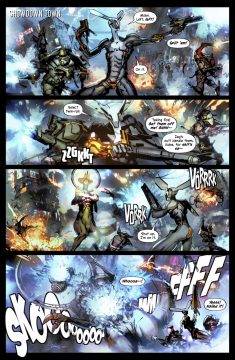Review: Crayta #1-4 (Unit 2 Games)
If you’re going to produce a comic based on an epic sci-fi video game, then hiring a writer with the pedigree of Dan Abnett (Marvel UK, Guardians of the Galaxy, Marvel Cosmic) is a pretty good start. Espeically if you then recruit some of indie comics most exciting names like Gustaffo Vargas (MANU) and Emma Viecelli (Breaks). But can this all star cast make the speculative science fiction of the world of Crayta into a comic worth digging into.
 Publisher: Unit 2 Games
Publisher: Unit 2 Games
Writer: Dan Abnett, Hannah Waddilove (Editor)
Artist: Gustaffo Vargas, Valentine De Landro, Mark Harrison, Paulina Ganucheau, Emma Vieceli, Mark Robert’s (cover art), Andrea Izzo (Colorist – De Landro pages), Simon Bowland (Letterer)
Price: Free from crayta.com/comic
In the future world of Crayta, the Earth is shaken by a global catastrophe when an asteroid impacts just outside New York, leaving a gigantic crater, killing millions and bringing humanity to the brink of social and economic catastrophe. This leads to the governments and people of the world to usher in coexistence, allowing the combination of the world’s Artificial Intelligences to come together to lead the human race to survival from this tragedy. Now, almost 60 years later, Earth is a paradise. However, when Nuna Heath, one of the architects of this new world order, is contacted by a group against co-existence, she finds herself assisting Interaction, Coexistence’s ‘secret police’ to locate the culprit, who might just have ties to her granddaughter. Meanwhile, halfway a world away, gamer Kobe is the best player of Showdown Town. However, when Kobe shares his dissatisfaction of the game’s repetition, he finds himself approached with a chance to try a new, coexistence unapproved game, leading to his own encounter with Interaction. What connects these three people, what makes them so special and what is Crayta?
Dan Abnett has created an extremely compelling world within the pages of Crayta. Set in the backdrop of a post-tragedy, post-governmental changed Earth, Crayta’s environment feels very multi-layered, with additional infographics reminiscent of a Jonathan Hickman comic (who is a master of creating in depth worlds) and ‘in-world’ advertisements giving the whole series a very ‘Lazarus‘ feel. As for the story, Crayta’s narrative has all the making of a complex political thriller as Abnett borders the line of an all-out sci-fi epic that imbues one or two deep ‘Outer Limits’-esque notions. The characters, while not tremendously fleshed out, are well written and really help anchor the reader into this rather unbelievable world. In fact, the only issue that came from the first four issues is its opening instalment, which appeared to lack pace or direction. Of course, given the amount of world building info it needed to expose, this is understandable and, fortunately, the subsequent issues more than made up for the opener’s shortcomings.
 The art, meanwhile, is fantastic and while that is understandable given the array of talent involved, it is immensely surprising just how well the different styles of Vargas, Vieceli and the rest mesh. From the very first page, the artwork imbues a sci-fi tone similar to that of Black Science as Nuna and her husband reminisce only to find their location is not what it appears in very Star Trek way. Of course, the consistency is not flawless as each artists respective ‘traditional’ styles does shine through (though would you expect anything less with a cast of talent this impressive). However, the art from beginning to end still such a wonder to look at that any differences from one page to the next are easily ignored. Then there is the lettering which, Simon Bowland (who, ironically, has lettered on the previously mentioned Lazarus) who goes above and beyond in panels such as the ones set within Showdown Town.
The art, meanwhile, is fantastic and while that is understandable given the array of talent involved, it is immensely surprising just how well the different styles of Vargas, Vieceli and the rest mesh. From the very first page, the artwork imbues a sci-fi tone similar to that of Black Science as Nuna and her husband reminisce only to find their location is not what it appears in very Star Trek way. Of course, the consistency is not flawless as each artists respective ‘traditional’ styles does shine through (though would you expect anything less with a cast of talent this impressive). However, the art from beginning to end still such a wonder to look at that any differences from one page to the next are easily ignored. Then there is the lettering which, Simon Bowland (who, ironically, has lettered on the previously mentioned Lazarus) who goes above and beyond in panels such as the ones set within Showdown Town.
Crayta is a fantastic read as Dan Abnett and his gang of fantastic artists deliver us an unbelievably gripping series. Despite a bumpy start, the solid writing and gorgeous art have made this in a must- read series as Abnett creates a masterclass in speculative sci-fi fiction which asks, when it comes to technological advancement, is the question we ask be, ‘should we?’



July 15, 2025 @ 2:01 am
Thanks for sharing. I read many of your blog posts, cool, your blog is very good.